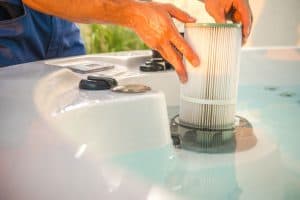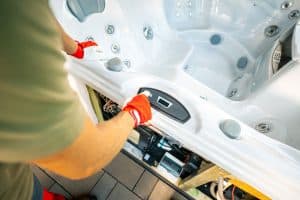Owning a hot tub is a luxurious treat, but without proper care, it can become more of a hassle than a haven. Whether you’re new to spa ownership or simply want to improve your routine, this hot tub maintenance guide will help you keep your water crystal clear and your system running efficiently.
Why Hot Tub Maintenance Matters
Hot tubs are a breeding ground for bacteria if not properly maintained. Routine cleaning and maintenance extend the life of your spa, keep running costs low, and ensure a safe, relaxing experience for all users.
Weekly Hot Tub Maintenance Checklist
1. Test and Balance the Water Chemistry
- Check pH levels (ideal range: 7.2 – 7.8)
- Test alkalinity (80 – 120 ppm)
- Add sanitiser (chlorine or bromine)
2. Clean the Waterline
- Wipe away oily residue to prevent build-up
- Use spa-safe cleaning cloths or mild detergent
3. Check for Debris
- Skim leaves or dirt from the water
- Empty the skimmer basket if applicable
4. Inspect the Filter
- Rinse with a hose to remove surface grime
- Rotate between clean filters if you have spares
Monthly Hot Tub Maintenance Tasks
- Deep-clean the filter with a filter cleaning solution
- Add spa shock to remove organic contaminants
- Inspect the spa cover for signs of wear and water absorption
Quarterly Maintenance: Drain and Refill
Every 3-4 months, drain your spa completely and refill with fresh water. This reduces the risk of TDS (Total Dissolved Solids) build-up and ensures water remains responsive to chemicals.
Steps:
- Turn off the power
- Attach a hose to the drain spout
- Let it empty completely
- Clean the shell thoroughly
- Refill and re-balance water chemistry
Seasonal Tips for Hot Tub Maintenance in the UK
Winter Care
- Keep your hot tub running to prevent freezing
- Use a thermal spa cover to retain heat
- Check water levels regularly in cold snaps
Summer Care
- Increase filter cycles during high usage
- Use a floating dispenser to maintain sanitiser levels
- Keep the cover off occasionally to avoid water overheating
Common Hot Tub Maintenance Mistakes to Avoid
- Overusing chemicals: Can cause skin irritation and damage spa components
- Neglecting the filter: Reduces water flow and heating efficiency
- Ignoring water levels: Can burn out pumps if too low
Recommended Products for Spa Maintenance
- Non-foaming surface cleaner
- Spa shock oxidiser
- 5-in-1 water testing strips
- High-quality chlorine or bromine granules
Explore our full range of trusted products and services on our hot tub maintenance page.
Benefits of Regular Hot Tub Maintenance
- Prolongs equipment lifespan
- Reduces repair costs
- Enhances water hygiene and comfort
- Maintains resale value of your spa
A consistent hot tub maintenance routine ensures your spa remains a relaxing and hygienic oasis all year long. With just a little effort each week, you’ll avoid costly repairs and enjoy peace of mind knowing your investment is protected.
Ready to make maintenance effortless? Let Total Hot Tubs support you with expert advice, quality products, and tailored servicing packages.
Contact Us
Phone: 0800 999 8707
Email: info@totalhottubs.co.uk
Website: Total Hot Tubs Maintenance
FAQs
Q1: How often should I clean my hot tub filter?
A1: For the best water quality and efficiency, rinse your filter with clean water at least once a week to remove debris, oils, and hair. A deeper chemical soak should be done monthly to break down hidden build-up.
Q2: What’s the ideal water temperature for regular use?
A2: Most users find 37°C to 39°C ideal for safe, comfortable soaking. Higher temperatures can pose health risks, while cooler settings may feel less relaxing.
Q3: Can I use household cleaners on my hot tub?
A3: No, it’s important to only use spa-approved cleaning products. Household cleaners often contain harsh chemicals or foaming agents that can damage the shell, upset the water’s chemical balance, or even harm bathers.





